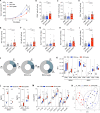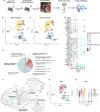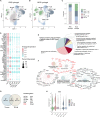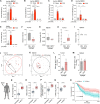BCG hydrogel promotes CTSS-mediated antigen processing and presentation, thereby suppressing metastasis and prolonging survival in melanoma
- PMID: 35732347
- PMCID: PMC9226922
- DOI: 10.1136/jitc-2021-004133
BCG hydrogel promotes CTSS-mediated antigen processing and presentation, thereby suppressing metastasis and prolonging survival in melanoma
Abstract
Background: The use of intralesional Mycobacterium bovis BCG (intralesional live BCG) for the treatment of metastatic melanoma resulted in regression of directly injected, and occasionally of distal lesions. However, intralesional-BCG is less effective in patients with visceral metastases and did not significantly improve overall survival.
Methods: We generated a novel BCG lysate and developed it into a thermosensitive PLGA-PEG-PLGA hydrogel (BCG hydrogel), which was injected adjacent to the tumor to assess its antitumor effect in syngeneic tumor models (B16F10, MC38). The effect of BCG hydrogel treatment on contralateral tumors, lung metastases, and survival was assessed to evaluate systemic long-term efficacy. Gene expression profiles of tumor-infiltrating immune cells and of tumor-draining lymph nodes from BCG hydrogel-treated mice were analyzed by single-cell RNA sequencing (scRNA-seq) and CD8+ T cell receptor (TCR) repertoire diversity was assessed by TCR-sequencing. To confirm the mechanistic findings, RNA-seq data of biopsies obtained from in-transit cutaneous metastases of patients with melanoma who had received intralesional-BCG therapy were analyzed.
Results: Here, we show that BCG lysate exhibits enhanced antitumor efficacy compared to live mycobacteria and promotes a proinflammatory tumor microenvironment and M1 macrophage (MΦ) polarization in vivo. The underlying mechanisms of BCG lysate-mediated tumor immunity are dependent on MΦ and dendritic cells (DCs). BCG hydrogel treatment induced systemic immunity in melanoma-bearing mice with suppression of lung metastases and improved survival. Furthermore, BCG hydrogel promoted cathepsin S (CTSS) activity in MΦ and DCs, resulting in enhanced antigen processing and presentation of tumor-associated antigens. Finally, BCG hydrogel treatment was associated with increased frequencies of melanoma-reactive CD8+ T cells. In human patients with melanoma, intralesional-BCG treatment was associated with enhanced M1 MΦ, mature DC, antigen processing and presentation, as well as with increased CTSS expression which positively correlated with patient survival.
Conclusions: These findings provide mechanistic insights as well as rationale for the clinical translation of BCG hydrogel as cancer immunotherapy to overcome the current limitations of immunotherapies for the treatment of patients with melanoma.
Keywords: antigen presentation; dendritic cells; immunotherapy; macrophages; melanoma.
© Author(s) (or their employer(s)) 2022. Re-use permitted under CC BY. Published by BMJ.
Conflict of interest statement
Competing interests: None declared.
Figures






References
Publication types
MeSH terms
Substances
LinkOut - more resources
Full Text Sources
Medical
Research Materials
Miscellaneous
